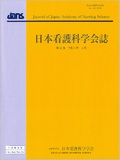Japanese
English
- 販売していません
- Abstract 文献概要
- 参考文献 Reference
要旨
目的:ICUの勤務帯リーダー看護師の臨床判断に基づく実践を明らかにすること.
方法:観察法と半構造化面接法を用い,ICUでの勤務帯リーダー経験が1年以上の者を対象とした.
結果:研究参加者は15名で,リーダー経験は平均4.5年であった.分析の結果,8つのカテゴリが抽出され,【患者情報獲得の必要性に応じた情報収集手段の見極めと駆使】,【治療・看護における不測の事態を想定した目配り】,【患者の危機状態の迅速な判断に基づいた危機管理体制の立ち上げ】,【患者の重症度と看護師の能力のバランスを評価して繰り返す看護チームの再編】,【患者に生じる問題の変化に応じた医療チーム全体への対策の主導】,【医療職間での共通認識の形成状況に応じたチームの協働の促進】,【治療・看護の提供状況の適切性の判断に基づく資源の差配】,【看護師の力量判断に基づく重症患者看護についての教育の提供】が明らかになった.
結論:ICUの勤務帯リーダー看護師の実践は,患者の生命維持から看護師の教育に関わるものまで多岐に渡っていた.
Objectives: This study identified clinical judgment-based practices of ICU shift-leader nurses.
Methods: Data collected through using observation methods and semi-structured interviews. Study participants were those with at least one year of shift-leader experience in the ICU.
Results: There were 15 research participants, with a mean number of years of leadership experience of 4.5 years. The analysis resulted in the extraction and discovery of 8 categories: (1) identifying and applying information-gathering methods to determine patient information, as needed; (2) paying attention and anticipating unforeseen circumstances in the treatments; (3) launching a crisis management system based on rapid assessment of patient crises; (4) rebalancing the nursing team by continually evaluating patient status to leverage the abilities of the nurses; (5) leading medical teams in response to changes in patient problems; (6) promoting team collaboration to form a shared awareness among healthcare professionals; (7) distributing resources based on treatment appropriateness and nursing-provision status; and (8) providing nursing education on critically ill patients based on an assessment of the nurses' capabilities.
Conclusion: The practices of ICU shift-leader nurses range from patient life maintenance to nurse education.
Copyright © 2021, Japan Academy of Nursing Science. All rights reserved.


